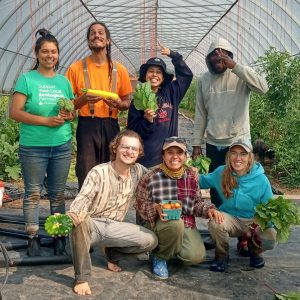What is Biodynamic Tree Paste?
Winter Application of Biodynamic Tree Paste
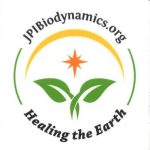 Originally Post by Josephine Porter Institute, January 2015
Originally Post by Josephine Porter Institute, January 2015
Biodynamic tree paste is applied once a year in late fall after leaf drop or in late winter before the sap flows and before bud break. It is applied in the descending moon (transplanting time in the Maria Thun Biodynamic Planting Calendar) and when the temperature is above freezing.
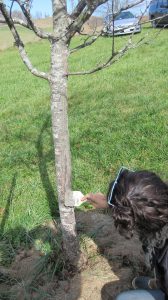 Tree paste is used to provide a protective covering primarily on the bark of fruit trees to enhance the vitality, to help protect the bark from splitting, to discourage insect breeding and infestation, to heal injuries and to cover wounds made during pruning. It may also be applied to fruiting bushes, vines and roses. A coating of the tree paste may slow blossoming so there is less danger of early frost damage. It is recommended for newly planted trees to give them a good start and it is also helpful for ailing or stressed trees.
Tree paste is used to provide a protective covering primarily on the bark of fruit trees to enhance the vitality, to help protect the bark from splitting, to discourage insect breeding and infestation, to heal injuries and to cover wounds made during pruning. It may also be applied to fruiting bushes, vines and roses. A coating of the tree paste may slow blossoming so there is less danger of early frost damage. It is recommended for newly planted trees to give them a good start and it is also helpful for ailing or stressed trees.
The tree bark should first be gently brushed or scraped to remove moss, lichens and dead, loose bark which provides breeding grounds for insects. Backyard gardeners can use a whitewash brush or paintbrush to apply the paste by completely covering smaller trees and the trunks and lower branches of larger trees. Care needs to be taken that you do not break off buds as you are brushing the paste on. The paste may be further diluted and strained to use as a spray to cover the upper branches of tall trees. Hand application is impractical for large orchards and the spray is used to cover the whole tree.
One of original recipes contained equal parts of sticky clay, cow manure and fine sand. Later, Dr. Ehrenfried Pfeiffer modified it by adding one stirred unit of BD#500 (horn manure) and .5 to 1.5 percent Equisetum arvense (BD#508) tea for its anti-fungal properties. Over the years, practitioners have developed their own variations according to their individual needs. JPI currently makes available a version that contains bentonite clay with the Pfeiffer BD Field and Garden Spray, fermented BD#508 (Equisetum arvense), castor oil and basalt. It may be ordered by the quart or gallon here: www.jpibiodynamics.org (ie. A quart of concentrated paste, diluted 1:2 or 1:3 will treat a few full sized trees or several smaller trees. Diluted into a spray (1:16), a quart will treat eight average sized apple trees.)
You may also make your own tree paste and a recipe with exact measurements for a few larger trees or several small trees appears in the Fall 2004, Applied Biodynamics, Issue No. 46 and you may download it free on the JPI website under Education/Using and Making Preparations. www.jpibiodynamics.org or you may contact the JPI office for a copy of the recipe at www.jpibiodynamics.org
There are also recipes in The Biodynamic Orchard Book by Ehrenfried Pfeiffer and Michael Maltas.
References:
The Biodynamic Orchard Book, Ehrenfried Pfeiffer and Michael Maltas, Floris Books, Edinburgh, 2013.
Bio-Dynamic Sprays, H.H. Koepf (based on a pamphet of the same name written by Evelyn Speiden Gregg) currently out of print Using the Biodynamic Compost Preparations and Sprays in the Garden, Orchard, and Farm, Ehrenfried Pfeiffer, currently out of print www.jpibiodynamics.org
How to Make a Biodynamic Tree Paste
by Hugh J. Courtney, reposted from the Celestial Planting Calendar 2019
Tree paste is an excellent way to fertilize a tree and help it deal with disease. It can be applied any time of the year but one preferred time is late in the fall or in late winter. Here is a simplified version with proportions calculated to make enough paste to apply to several trees.
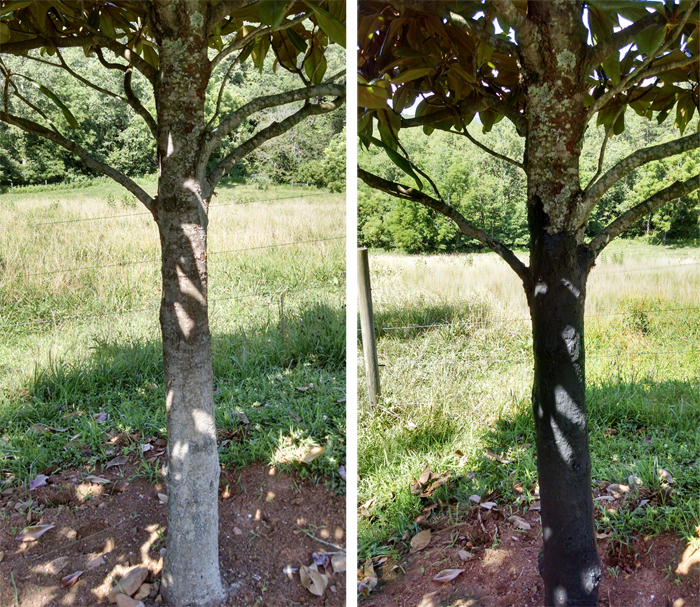
Suggested equipment and materials
- Power drill with ½ inch mixing chuck
- 5 or 6 gallon (19 or 23 litre) bucket
- 5 pounds (2.25 kilograms) bentonite clay
- 2 to 2.5 gallons (7.5 to 9.5 litres) water (see below)
- ½ gallon (2 litres) fermented Equisetum tea (BD508)
- 2 units ELA (Earth Legacy Agriculture) Field Activator
Preparing the water
Water from a well should be exposed to the sun and starlight for at least 24 hours prior to use. If the water is chlorinated, 48 hours of exposure is recommended. Fresh, not stagnant, pond water is acceptable. Recently collected rainwater is preferred but be aware of its acidic properties. The ideal container for exposing water to sunlight is a copper kettle or a ceramic crock. A stainless steel container can also be used. A plastic bucket is a last resort, but never uses an aluminum container.
Tree Paste Instructions
Place two gallons of non-chlorinated water in a five- or six-gallon plastic bucket. Slowly add the clay while stirring contents using the power drill mixer. Mix the water thoroughly with the clay (20 minutes). Hand mixing requires several hours. When half of the clay has been added, slowly add the ELA Field Activator and the fermented Equisetum tea and continue to stir.
Add the remaining clay until the mixture is thick and paste-like. Let it sit for a few hours. Stir again slightly to see if additional water is needed. If the material is to be applied in a spray form, dilute to the desired consistency suitable for your spray equipment—possibly twice as much water as originally called for. Three units each of Biodynamic Compound (BC) Preparation and Horn Manure (BD500) may be substituted for the two units of the Field Activator.
Prior to applying tree paste, remove as much loose bark as possible using a wire brush, putty knife or other scraping tool. Use an extra-large brush to apply the paste to the tree trunk and larger lower limbs. Heavy duty rubber gloves may also be used.
Binding agents sometimes used
- Castor oil: ¼ cup or less, also used as a healing agent
- Linseed oil: ¼ cup or less
Some recipes add Horn Silica (BD501) preparation, powdered stinging nettle, liquid seaweed, whey, diatomaceous earth, lime, as well as other helpful ingredients. For further reading on tree care and how to apply tree paste, see Ehrenfried Pfeiffer’s The Biodynamic Treatment of Fruit Trees, Berries and Shrubs.
Fermented Horsetail Tea (BD508) Equisetum arvense
Take one unit of shredded horsetail herb. One unit is less than 1.5 ounces by weight or 8 to 10 ounces by volume depending on how finely it is shredded.
In one gallon of water, bring the shredded horsetail to a boil and simmer for one full hour. Use a stainless steel or porcelain pot, not an aluminum one. Allow the tea to cool and transfer both the liquid and the cooked herb to a crock or other storage container. Cover with a loose fitting lid.
Store this mixture in a cool place, for example, a root cellar or a basement, and allow it to ferment for 10 to 14 days. A characteristic smell will develop. Then strain the herb particles out, transfer the tea into a glass jug, and store it in the cool, dark place until it is to be used.
This fermented tea can be stored for six or more months without losing its effectiveness. If desired, the strained horsetail material can be used to make the next batch thereby helping to speed up the fermentation process.
Note: After the passing of Hugh Courtney, Earth Legacy Agriculture LLC has since closed their doors. For products mentioned above, contact www.jpibiodynamics.org
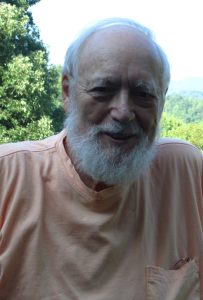 Hugh Courtney - Writer, Mentor, Researcher
Hugh Courtney - Writer, Mentor, Researcher
In addition to contributing articles, Hugh Courtney has taken on the advisory role of forecasting favourable and unfavorable times for this calendar. He has devoted more than 40 years to perfecting the art of making biodynamic preparations. Taking a cue from his own mentor, Josephine Porter, who declared, “These preparations are no secret, I will teach anyone who wants to learn how to make them,” he has mentored hundreds of people on the finer points of making quality preparations.
Ever concerned about keeping this special art form alive into the future, in 2009, along with his grandson, Jeremiah Proctor, Hugh founded Earth Legacy Agriculture, LLC to provide quality preparations for discerning practitioners.

